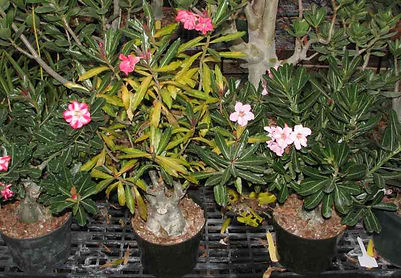An Adenium Website
_edited.png)
_edited_edited.png)
_edited.png)
_edited_edited.png)
Dormancy
In botany, "dormant" means not actively growing. Dormant plants may retain leaves and still conduct photosynthesis, and they may also flower.

Dormant and deciduous. Water consumption is nearly zero. Adenium "arabicum".

In leaf, but dormant because no new leaves are being produced. Adenium "obesum". Water such plants sparingly; it doesn't consume much in this state.

In leaf, but dormant because no new leaves are being produced. Adenium "obesum". Water such plants sparingly; it doesn't consume much in this state.

Dormant and deciduous, but flowering. Water use is still minimal. Adenium "arabicum" 'Hansoti Dwarf'.

In leaf and flowering, but it's still dormant because no new leaves are being produced. This plant uses much less water than when it is growing new stems. Adenium "arabicum"

In some adeniums part or all of the foliage will suddenly turn yellow and fall. This plant has entered dormancy and watering must be sharply reduced or stopped. Adenium crispum X "obesum" hybrid 'New Star'. The dormant plant is flanked by two other crispum hybrids that are still actively growing.
Growing and Active
In botany, "dormant" means not actively growing. Dormant plants may retain leaves and still conduct photosynthesis, and they may also flower.

This Adenium socotranum is breaking dormancy. Water use is still low, but it needs some to stimulate waking up.

This 'Arabian Ruby' was evergreen through the winter, and is now breaking dormancy by producing new leaves in spring.

Growing: The soft green stem of this 'Crimson Star' reveals active stem elongation as well as rapid new leaf production.

This 'Arabian Ruby' was evergreen through the winter, and is now breaking dormancy by producing new leaves in spring.

Active. Not dormant, but not really growing either. If kept warm and moist in winter, some adeniums continue making new leaves at a slow pace, but stem elongation is minimal. Water use is much less than during the summer growing season.




